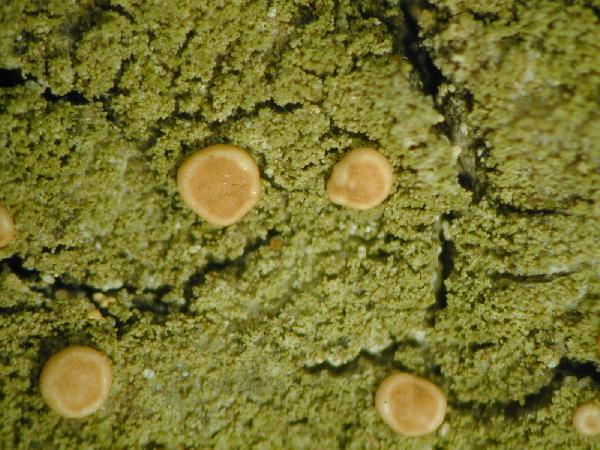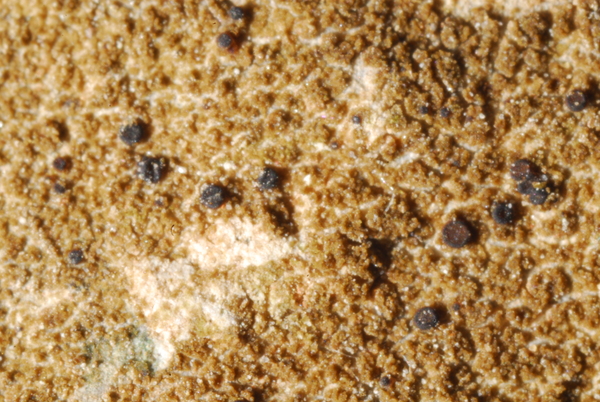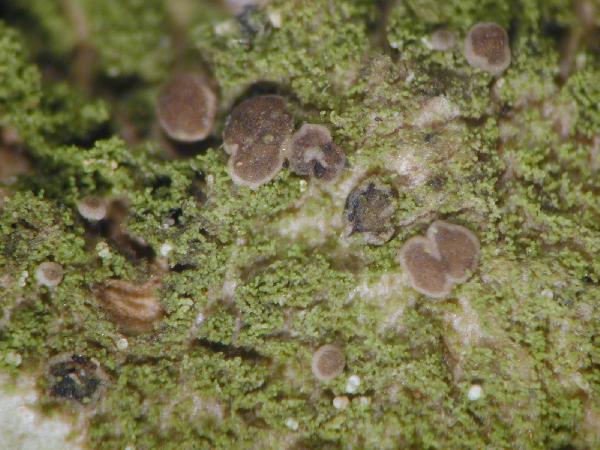Bacidina arnoldiana (Körb.) V. Wirth & Vězda
in Wirth, Stuttg. Beitr. Naturk., ser. A, 517: 62, 1994. Basionym: Bacidia arnoldiana Körb. - Parerga Lichenol.: 134, 1860.
Synonyms: Lecidea arnoldiana (Körb.) A.Harm.; Lecidea larbalestieri Cromb.; Woessia arnoldiana (Körb.) Sérus. & Diederich
Distribution: N - VG, Frl, Ven (Thor & Nascimbene 2007), TAA (Nascimbene & al. 2022), Lig. C - Tosc (Tretiach & al. 2008), Marc (Nimis & Tretiach 1999), Abr (Nimis & Tretiach 1999, Gheza & al. 2021). S - Camp (Ricciardi & al. 2000), Pugl (Nimis & Tretiach 1999), Bas (Potenza & al. 2014), Cal (Puntillo 1996).
Description: Thallus crustose, finely granular, entirely consisting of 20-40 µm wide, green goniocysts that may or may not form coralline structures. Apothecia biatorine, 0.3-0.7(-1.3) mm across, with a white-grey to grey-brown disc, often with a slight violet hue, and a paler, raised, sometimes white-pruinose proper margin. Proper exciple without crystals, the rim colourless to pale brown, the hyphae towards the outer part with ellipsoidal lumina, 3-7 x 1.5-5 μm; epithecium scarcely differentiated from the hymenium; hymenium colourless or pale brown in upper part, up to 50 µm high; paraphyses 1-1.5(-2) µm thick at mid-level, the apical cells clavate to slightly thickened, up to 4 µm wide; hypothecium and adjacent exciple dark brown to red-brown K+ dark brown (Arnoldiana-brown pigment). Asci 8-spored, clavate to cylindrical-clavate, the apical dome K/I+ dark blue with a pale, conical-pointed apical cushion (axial mass) never penetrating through the entire d-layer, the wall K/I-, but the thin outer gel K/I+ blue, Bacidia-type. Ascospores 1-3(-7)-septate, hyaline, acicular, straight to curved, (19-)24-48 x 0.9-2 µm. Pycnidia white, immersed or slightly projecting, abundant or rare, 0.1-0.2 mm diam. Conidia thread-like, arched or curved, sometimes almost straight, without any hook at apex, 0-3(-5)-septate, 25-45 x 1-1.5 μm. Photobiont chlorococcoid, the cells 5-12 µm wide. Spot tests: thallus K-, C-, KC-, P-, UV-. Chemistry: thallus without lichen substances; Arnoldiana-brown pigment in apothecia.Note: a mild-temperate lichen found on more or less calciferous rocks in sheltered situations, especially in open woodlands; often sterile, and much overlooked. Some epiphytic records could refer to B. modesta.
Growth form: Crustose
Substrata: rocks
Photobiont: green algae other than Trentepohlia
Reproductive strategy: mainly asexual, by soredia, or soredia-like structures (e.g. blastidia)
Most common in areas with a humid-warm climate (e.g. most of Tyrrenian Italy)
Commonnes-rarity: (info)
Alpine belt: absent
Subalpine belt: absent
Oromediterranean belt: absent
Montane belt: extremely rare
Submediterranean belt: extremely rare
Padanian area: absent
Humid submediterranean belt: very rare
Humid mediterranean belt: extremely rare
Dry mediterranean belt: absent
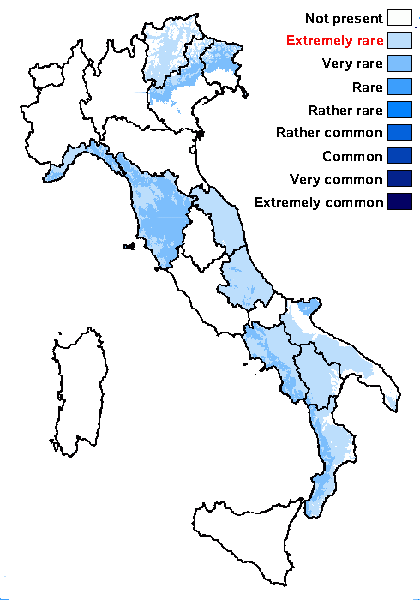
Predictive model
Herbarium samples
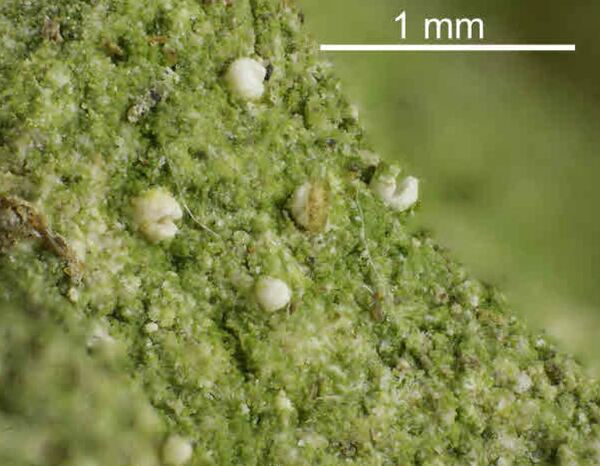

Felix Schumm – CC BY-SA 4.0
[17102], Germany, Baden-Württemberg, Alb-Donau-Kreis. 3,4 km NW von Westerheim. an Kalkfelsen beim Steinhaus nahe der Schertelshöhle, 48.537° N, 9.591° E, 800 m. Leg. et det. Schumm 01.05.2011
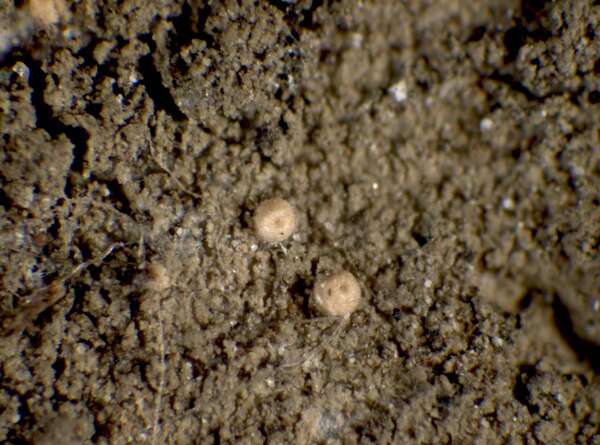

P.L. Nimis; Owner: Department of Life Sciences, University of Trieste
Herbarium: TSB (16124)
2001/12/12
young apothecia
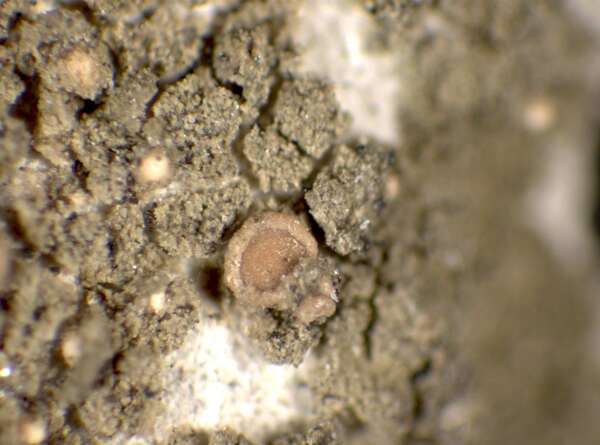

P.L. Nimis; Owner: Department of Life Sciences, University of Trieste
Herbarium: TSB (16124)
2001/12/12
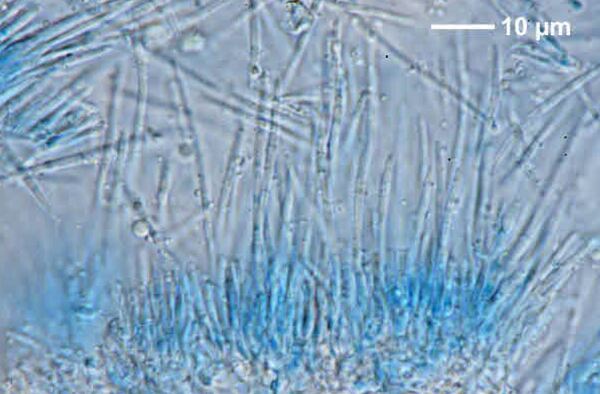

Felix Schumm – CC BY-SA 4.0
[17102], Germany, Baden-Württemberg, Alb-Donau-Kreis. 3,4 km NW von Westerheim. an Kalkfelsen beim Steinhaus nahe der Schertelshöhle, 48.537° N, 9.591° E, 800 m. Leg. et det. Schumm 01.05.2011
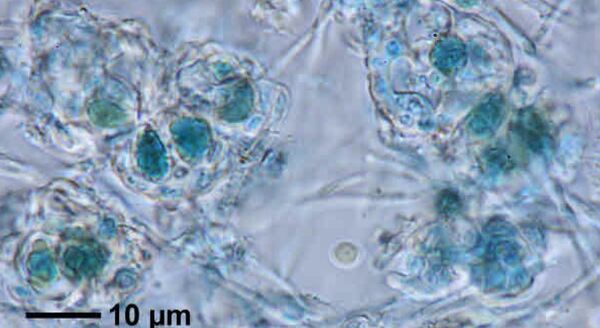

Felix Schumm – CC BY-SA 4.0
[17102], Germany, Baden-Württemberg, Alb-Donau-Kreis. 3,4 km NW von Westerheim. an Kalkfelsen beim Steinhaus nahe der Schertelshöhle, 48.537° N, 9.591° E, 800 m. Leg. et det. Schumm 01.05.2011
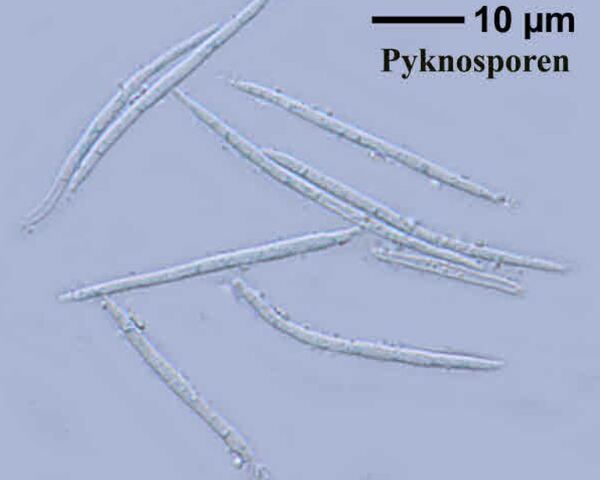

Felix Schumm – CC BY-SA 4.0
[17102], Germany, Baden-Württemberg, Alb-Donau-Kreis. 3,4 km NW von Westerheim. an Kalkfelsen beim Steinhaus nahe der Schertelshöhle, 48.537° N, 9.591° E, 800 m. Leg. et det. Schumm 01.05.2011
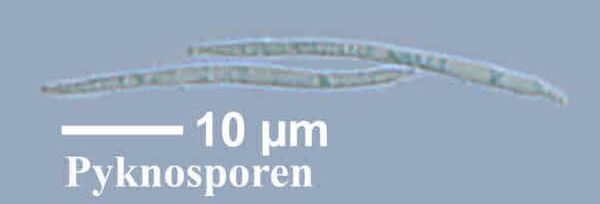

Felix Schumm – CC BY-SA 4.0
[17102], Germany, Baden-Württemberg, Alb-Donau-Kreis. 3,4 km NW von Westerheim. an Kalkfelsen beim Steinhaus nahe der Schertelshöhle, 48.537° N, 9.591° E, 800 m. Leg. et det. Schumm 01.05.2011


Felix Schumm - CC BY-SA 4.0
[14882], Germany, Baden-Württemberg, Kreis Göppingen, Marbachtal
bei Zell-Börtlingen. 48°45.140’ N, 9°38.745’ W, ca. 350 m, Waldrand in
Bachnähe, luftfeucht, lichtoffen, an Laubbaum, TK 7223. Leg.
Schumm 26.04.2009, det. Schumm.


Felix Schumm - CC BY-SA 4.0
[14882], Germany, Baden-Württemberg, Kreis Göppingen, Marbachtal
bei Zell-Börtlingen. 48°45.140’ N, 9°38.745’ W, ca. 350 m, Waldrand in
Bachnähe, luftfeucht, lichtoffen, an Laubbaum, TK 7223. Leg.
Schumm 26.04.2009, det. Schumm.
Growth form: Crustose
Substrata: rocks
Photobiont: green algae other than Trentepohlia
Reproductive strategy: mainly asexual, by soredia, or soredia-like structures (e.g. blastidia)
Most common in areas with a humid-warm climate (e.g. most of Tyrrenian Italy)
Commonnes-rarity: (info)
Alpine belt: absent
Subalpine belt: absent
Oromediterranean belt: absent
Montane belt: extremely rare
Submediterranean belt: extremely rare
Padanian area: absent
Humid submediterranean belt: very rare
Humid mediterranean belt: extremely rare
Dry mediterranean belt: absent

Predictive model
| Herbarium samples |


Felix Schumm – CC BY-SA 4.0
[17102], Germany, Baden-Württemberg, Alb-Donau-Kreis. 3,4 km NW von Westerheim. an Kalkfelsen beim Steinhaus nahe der Schertelshöhle, 48.537° N, 9.591° E, 800 m. Leg. et det. Schumm 01.05.2011


P.L. Nimis; Owner: Department of Life Sciences, University of Trieste
Herbarium: TSB (16124)
2001/12/12
young apothecia


P.L. Nimis; Owner: Department of Life Sciences, University of Trieste
Herbarium: TSB (16124)
2001/12/12


Felix Schumm – CC BY-SA 4.0
[17102], Germany, Baden-Württemberg, Alb-Donau-Kreis. 3,4 km NW von Westerheim. an Kalkfelsen beim Steinhaus nahe der Schertelshöhle, 48.537° N, 9.591° E, 800 m. Leg. et det. Schumm 01.05.2011


Felix Schumm – CC BY-SA 4.0
[17102], Germany, Baden-Württemberg, Alb-Donau-Kreis. 3,4 km NW von Westerheim. an Kalkfelsen beim Steinhaus nahe der Schertelshöhle, 48.537° N, 9.591° E, 800 m. Leg. et det. Schumm 01.05.2011


Felix Schumm – CC BY-SA 4.0
[17102], Germany, Baden-Württemberg, Alb-Donau-Kreis. 3,4 km NW von Westerheim. an Kalkfelsen beim Steinhaus nahe der Schertelshöhle, 48.537° N, 9.591° E, 800 m. Leg. et det. Schumm 01.05.2011


Felix Schumm – CC BY-SA 4.0
[17102], Germany, Baden-Württemberg, Alb-Donau-Kreis. 3,4 km NW von Westerheim. an Kalkfelsen beim Steinhaus nahe der Schertelshöhle, 48.537° N, 9.591° E, 800 m. Leg. et det. Schumm 01.05.2011


Felix Schumm - CC BY-SA 4.0
[14882], Germany, Baden-Württemberg, Kreis Göppingen, Marbachtal bei Zell-Börtlingen. 48°45.140’ N, 9°38.745’ W, ca. 350 m, Waldrand in Bachnähe, luftfeucht, lichtoffen, an Laubbaum, TK 7223. Leg. Schumm 26.04.2009, det. Schumm.


 INDEX FUNGORUM
INDEX FUNGORUM
 GBIF
GBIF
 DOLICHENS
DOLICHENS
